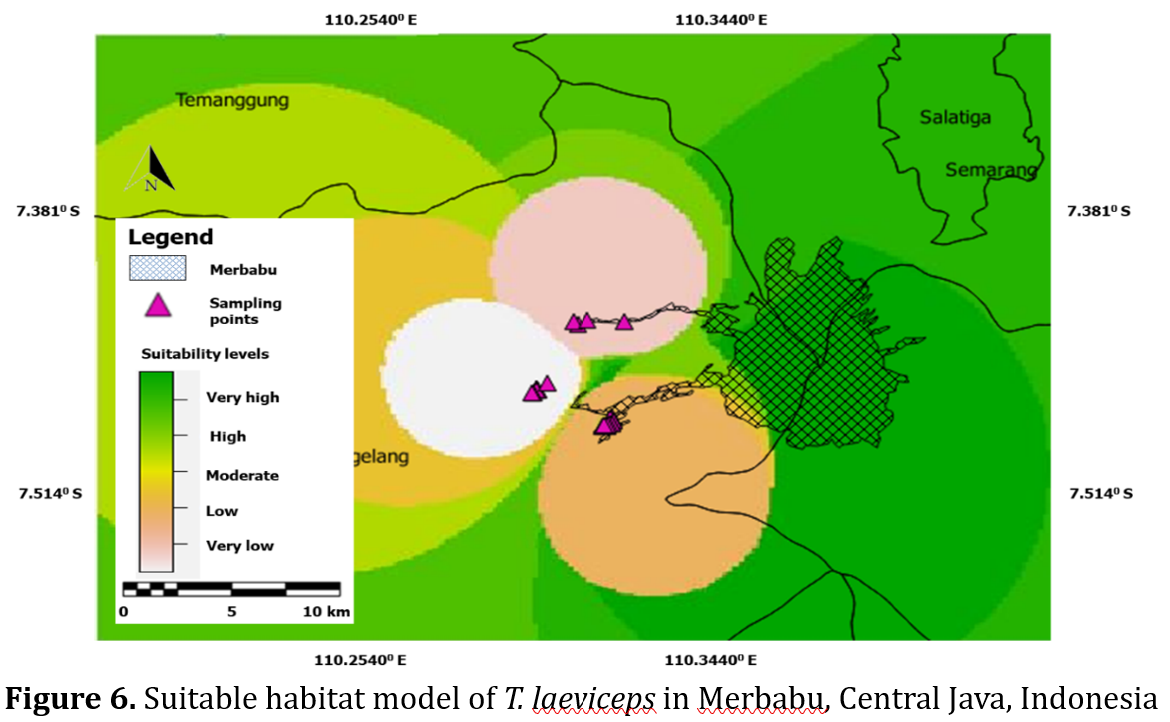Modeling suitable habitats of stingless bee klanceng (Tetragonula laeviceps) in Merbabu Mountain areas related to elevation, temperature, and humidity variables

Downloads
Klanceng is one of the stingless bee species in Indonesia with the scientific name Tetragonula laeviceps. This bee species has sustainable economic values since it has a role as a pollinator. This species is also common in mountainous areas, including Merbabu Mountain, Central Java. Despite this bee being very common, information about potential distributions of this bee is very limited, and this information is needed for its management. This study aimed to model the potential habitat for T. laeviceps using species distribution modeling (SDM) with elevation, temperature, and humidity as predictors. The model was built based on the T. laeviceps occurrence points gained through field surveys, with a total of 23 sampling points. According to the model, most of the west parts of Merbabu Mountain were considered not suitable for T. laeviceps. This suitability is also similar to the north and south parts. This condition is in contrast to the areas that bordered with the Merbabu Mountain directly. Most areas adjacent to the Merbabu Mountain were having high and very high suitability for T. laeviceps. Regarding altitudinal distribution, T. laeviceps was limited at elevations of 1000 m.
Alfian, R. (2022). Klanceng (Hymenoptera: Meliponini) di hutan Lindung Petungkriyono, Pekalongan, Jawa Tengah. [Skripsi S1 Fakultas Biologi]. Universitas Gadjah Mada.
Al-Khalaf, A., (2021). Modeling the potential distribution of the predator of honey bees, Palarus latifrons, in the Arabian deserts using Maxent and GIS. Saudi Journal of Biological Sciences, 28(10), 5667-5673. https://doi.org/10.1016/j.sjbs.2021.06.012.
Bivand, R. (2022). R packages for analyzing spatial data: a comparative case study with areal data. Geographical Analysis, 54(3), 488-518. https://doi.org/10.1111/GEAN.12319.
Efin, A., Atmowidi, T., & Prawasti, T.S. (2019). Short communication: morphological characteristics and morphometric of stingless bee (Apidae: Hymenoptera) from Banten Province, Indonesia. Biodiversitas: Journal of Biological Diversity, 20(6), 1693-1698. https://doi.org/10.13057/biodiv/d200627.
Ghassemi-Khademi, T., Khosravi, R., Silva, D.P., Kandemir, I., Krutmuang, P., & Sadeghi, S. (2023). Predicting the past, current, and future climate niche distribution of Tetragonula iridipennis Smith 1854 (Apidae: Meliponini) across the Indomalayan realm: insights into the impact of climate change. Journal of Apicultural Research, 61(5), 619-631. https://doi.org/10.1080/00218839.2022.2107975.
Gonzalez, V.H., Oyen, K., Vitale, N., & Ospina, R. (2022). Neotropical stingless bees display a strong response in cold tolerance with changes in elevation. Conservation Physiology, 10(1), coac073. https://doi.org/10.1093/conphys/coac073.
Hosni, E.M., Al-Khalaf, A.A., Nasser, M.G., Abou-Shaara, H.F., & Radwan, M.H. (2022). Modeling the potential global distribution of honeybee pest, Galleria mellonella under changing climate. Insects, 13(5), 484. https://doi.org/10.3390/insects13050484.
Jalil, A., & Shuib, I. (2012). Indo-Malayan stingless bees: pictorial identification guide and composite algorithm.
Kahono, S., & Erniwati, E. (2014). Keragaman dan kelimpahan lebah sosial (Apidae) pada bunga tanaman pertanian musiman yang diaplikasi pestisida di Jawa Barat. Berita Biologi, 13(3), 231-238. https://doi.org/10.14203/beritabiologi.v13i3.660.
Khan, A.M., Li, Q., Saqib, Z., Khan, N., Habib, T., Khalid, N., Majeed, M., & Tariq A. (2022). MaxEnt modelling and impact of climate change on habitat suitability variations of economically important Chilgoza Pine (Pinus gerardiana Wall.) in South Asia. Forests, 13, 715. http://dx.doi.org/10.3390/f13050715.
Lemenkova, P. (2020). Using R packages 'Tmap', 'Raster' And 'Ggmap' for cartographic visualization: an example of dem-based terrain modelling of Italy, Apennine Peninsula. Zbornik radova - Geografski fakultet Univerziteta u Beogradu, 68, 99-116. http://dx.doi.org/10.5937/zrgfub2068099L.
Mao, M., Chen, S., Ke, Z., Qian, Z., & Xu, Y. (2022). Using MaxEnt to predict the potential distribution of the little fire ant (Wasmannia auropunctata) in China. Insects, 13, 1008. http://dx.doi.org/10.3390/insects13111008.
Patel, V., Boruff, B., Biggs, E., Pauli, N., & Dixon, D.J. (2023). Temporally stacked bee forage species distribution modeling for flower abundance mapping. MethodsX, 11, 102327. https://doi.org/10.1016/j.mex.2023.102327.
Pratama, M.N., Agus, A., Umami, N., Agussalim, A., & Purwanto, H. (2023). Morphometricand molecular identification, domestication, and potentials of stingless bees (Apidae: Meliponini) in Mount Halimun Salak National Park, West Java, Indonesia. Biodiversitas, 24(11), 6107-6118. https://doi.org/10.13057/biodiv/d241132.
Rachmawati, R.D., Agus, A., Umami, N., Agussalim, A., & Purwanto, H. (2022). Diversity, distribution, and nest characteristics of stingless bees (Hymenoptera: Meliponini) in Baluran National Park, East Java, Indonesia. Biodiversitas, 23(8), 3890-3901. https://doi.org/10.13057/biodiv/d230805.
Rojas-Arias, L., Gómez-Morales, D., Stiegel, S., & Ospina-Torres, R. (2023). Niche modeling of bumble bee species (Hymenoptera, Apidae, Bombus) in Colombia reveals highly fragmented potential distribution for some species. Journal of Hymenoptera Research, 95, 231-244. https://doi.org/10.3897/jhr.95.87752.
Salatnaya, H., Widodo, W.D., Winarno, & Fuah, A.M. (2020). The influence of environmental factors on the activity and propolis production of Tetragonula laeviceps. Jurnal Ilmu Produksi Dan Teknologi Hasil Peternakan, 8(2), 67-71. https://doi.org/10.29244/jipthp.8.2.67-71.
Trianto, M., & Purwanto, H. (2020). Morphological characteristics and morphometrics of Stingless Bees (Hymenoptera: Meliponini) in Yogyakarta, Indonesia. Biodiversitas, 21(6), 2619-2628. https://doi.org/10.13057/biodiv/d210633.
Trianto, M., Arisuryanti, T., Purwanto, H., & Ubaidillah, R. (2023). Updated species check-list of the Indonesian stingless bees (Hymenoptera, Apidae, Apinae, Meliponini). Journal of Tropical Biodiversity and Biotechnology, 8(2), 77160. https://doi.org/10.22146/jtbb.77160.
Wahyudi, J. (2019). Kekayaan flora anggrek di Taman Nasional Gunung Merbabu. Jakarta: Direktorat Jenderal Konservasi Sumber Daya Alam dan Ekosistem.
Wongsa, K., Duangphakdee, O., & Rattanawannee, A. (2023). Pollination efficacy of stingless bees, Tetragonula pagdeni Schwarz (Apidae: Meliponini), on greenhouse tomatoes (Solanum lycopersicum Linnaeus). PeerJ, 11, e15367. https://doi.org/10.7717/peerj.15367.
Zhang, K., Lin, S., Ji, Y., Yang, C., Wang, X., Yang, C., Wang, H., Jiang, H., Harrison, R. D., & Yu, D.W. (2016). Plant diversity accurately predicts insect diversity in two tropical landscapes. Molecular Ecology, 25(17), 4407–4419. https://doi.org/10.1111/mec.13770.




